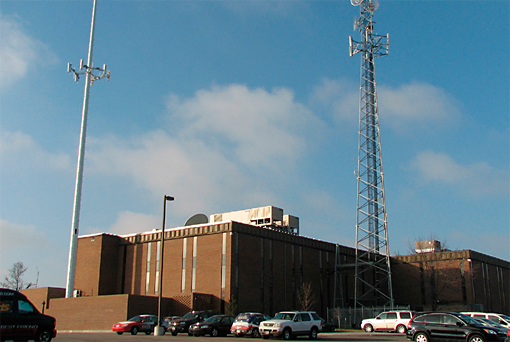| 제목 | [DAIKIN] OFFICE BUILDING - Entercom Communications | 작성일 | 16-06-16 11:20 |
| 글쓴이 | 최고관리자 | 조회수 | 4,127 |
본문
CASE STUDY
Office Building
Daikin Applied Rooftop Systems Help Reduce Vibration and Radiated Sound for Kansas City Radio Stations
When Kansas City residents tune in to KMBZ radio, their local ABC-affiliated news and sports station, they hear crystal-clear communication. It's the result not only of the latest broadcast technology, but also of a "down-to-the-studs" renovation of the building that houses all eight of the Kansas City radio stations owned by Entercom Communications. Daikin rooftop systems help to ensure that the only audible "hum" might be from a vocalist on WDAF country radio.
Entercom Communications, based in Pittsburgh, Penn., is one of the largest owners of AM and FM radio stations in the U.S. The Kansas City stations appeal to a variety of audiences—formats include news, sports, talk, rock, classical and country—but none of the stations' listeners would appreciate hearing HVAC noise along with their favorite tunes.
Reducing Noise and Vibration
Entercom completed a $12 million renovation of the 60,000-square-foot building in October 2006. The building houses tenants on the first floor, studio personnel on the second and broadcasting studios for its eight radio stations on the third. Located on the corner of a busy intersection, the all-steel, prefabricated building required significant renovation to overcome outside noise from traffic and inside noise from reverberation.
"Our acoustical requirement was between NC 20 and NC 25," said Dave Dawson, principal of W.L. Cassell, the mechanical and engineering firm in Kansas City that completed the mechanical renovation. "It was all about making sure any equipment we put in didn't carry into the studio through ductwork or radiate through the walls. We needed a solid, rigid HVAC system as well as a quiet one to prevent vibration and radiated sound."
Meeting an NC (noise criteria) requirement of 20 to 25 is challenging. Rooms in this range are considered "very quiet" and include concert and recital halls and broadcast and recording studios. HVAC systems can be a significant contributor to background noise, so Dawson also had to factor in air velocities for supply and return air. Recommended airflow for a room this quiet is 250 to 300 feet per minute (fpm) for supply air and 300 to 360 fpm for return air.
Rooftop Location and the Low Noise Challenge
Isolating the broadcast studios on the third floor from noise was relatively straightforward. "The studios are essentially a room within a room," said Dawson. "One room is built inside the other and separated by the sound insulation. Duct silencers in the insulation help kill any air noise generated by air moving through the ductwork or any noise generated by the control damper or VAV box."
The bigger challenge was finding a place for the new HVAC equipment. Dawson would have recommended a separate mechanical room, but Entercom needed as much space as possible for tenants, offices and studios. That left the roof as the only choice for the new HVAC installation. Working with Thermal Components, an HVAC supplier in Kansas City, Dawson was able to design a system with the flexibility to meet his low-noise requirements.
Two Daikin rooftop units were selected to serve the year-round cooling load of up to 175 tons for the top two floors. A 100-ton unit provides year-round cooling to the top floor. A 75-ton unit serves the second floor. Both units are controlled by MicroTech® II controls with Daikin's Open Choices® feature, which simplified integration into the Andover building automation system. Variable air volume boxes with hot-water boilers provide zone control and heat the building. First-floor spaces are served by a Daikin Vision® air handling unit, an exterior 60-ton condensing unit and two 50-ton rooftop units. "The Daikin units give us the performance we need for acoustic reverberation and radiated sound," said Dawson. "Discharge sound is mainly attributed to the fan of a unit, so we chose plenum fans and wheels because they're much quieter than other fan configurations.
The flexibility to choose the fans and wheels we required helped us meet the NC requirements. And we were able to cut down on vibration and radiated sound because these units are built so solidly." To provide further soundproofing, the ceiling of each of the top-floor studios is resiliently suspended from the roof to avoid any vibration transmission from the rooftop equipment.
"Not only did we need a quiet system, we also needed a reliable one," said Dawson. "HVAC systems in studios are important not just for the people who work there, but also for the broadcast equipment, which must operate 24 hours a day." Kansas City listeners would be reassured to know that even the HVAC system has a role in keeping news, music and sports coming through loud and clear without a hint of background distraction.

Daikin rooftop units meet the performance standards required by Entercom Communications
| 이전글 | [DAIKIN] OFFICE BUILDING - DaimlerChrysler Headquarters 2016-06-16 | ||
| 다음글 | [DAIKIN] OFFICE BUILDING - IBM Canada Manufacturing 2016-06-16 | ||






